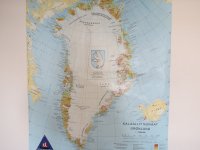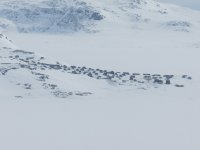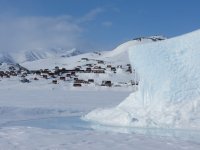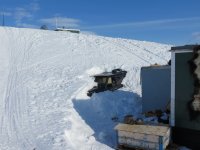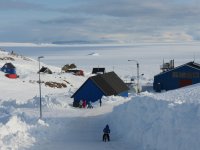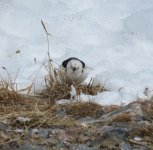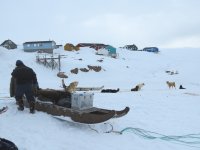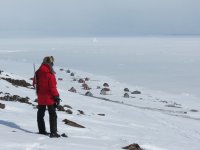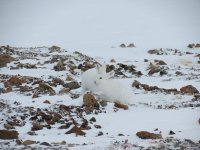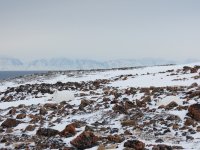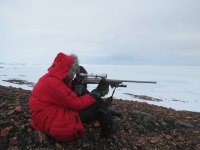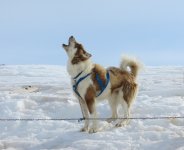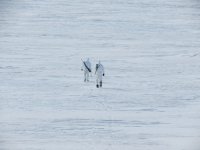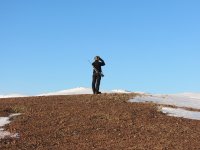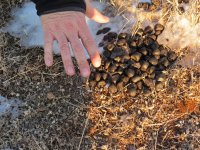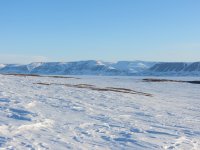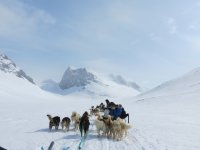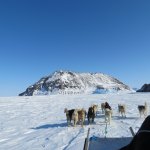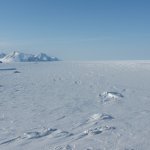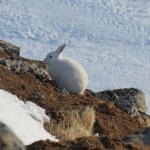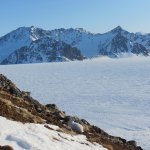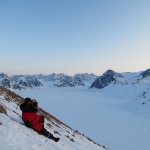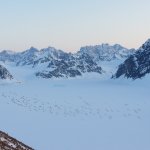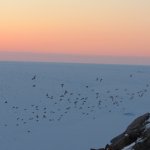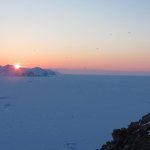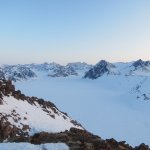Edward
Umimmak

This probably has the highest "words to birds ratio" of any trip report ever written but I thought I'd post it anyway as trip reports from Greenland are few and far between.
Introduction
In May I visited the isolated Greenlandic village of Ittoqqortoormiit and travelled along the outer coast of Liverpool Land by dogs led for six days. It’s an area of East Greenland which I’d been dreaming of visiting for many years. East Greenland is not a place visited by many birders; it's remote, expensive to get to and in terms of avian diversity, then it’s not exactly Ecuador. But one of the things I enjoy most about birding is seeing birds on their breeding grounds and in dramatic landscapes and East Greenland simply boasts some of the most spectacular scenery on Earth. East Greenland just turns my crank and I find the allure of the Far North simply irresistible. This is quite an affliction for a birder; money and valuable holiday time go into visiting a place where your bird list might make it into double figures if you are lucky, and the chances of a new species are virtually zero. But reducing the sheer magnificence of the High Arctic landscapes and the overwhelming sense of wilderness to the statistics of a short bird list does the place a great injustice. This is the Arctic you, or at least some of us, dream about.
Greenland is easily the most sparsely populated country on Earth and around 95% of its population lives on the west coast. East Greenland is isolated physically from the west coast by the ice sheet and only 3,000 people live on a coastline stretching 2,800 km. Around 2,500 people live in seven settlements in the Ammassalik area at 65°N. The remaining 470 inhabit Greenland’s remotest village, Ittoqqortoormiit, situated at the mouth of the world’s largest fjord, Scoresby Sund, at approximately 70°N. And it is remote: the closest village in Greenland lies 800 km to the south, while to the north a number of Danish scientists and military personnel live in splendid isolation at four research stations. Not surprisingly the area sees rather few tourists, mainly mountaineers, cross-country skiers, kayakers and hikers, plus the odd cruise ship in August when ice conditions allow ships to enter the fjord. Tourists travelling independently have to be well prepared because outside the village there are no facilities whatsoever, just wilderness for hundreds of kilometres in any direction. The area has a large Polar Bear population so it’s pretty much essential to be armed outside the village and to know how to use a rifle if the worst comes to the worst.
Getting there and getting around
Air Iceland (Flugfélag Íslands) flies on Wednesdays and Saturdays from Reykjavík to Nerlerit Inaat (Danish: Constable Pynt, English: Constable Point) in Jameson Land, which is an airport in the middle of nowhere, i.e. there is no settlement there, uninhabited wilderness starts as soon as you leave the airport. From there it is a 15-minute helicopter flight with Air Greenland (important to book in advance) to Ittoqqortoormiit, known as Scoresbysund in Danish. It’s not a cheap flight but the alternative is to walk the 39 km across Hurry Inlet and the mountains of Liverpool Land, in which case don’t forget that gun. East Greenland is one place you don’t need to worry about which car hire company to choose. In spring you can get around by snowmobile, dog sled, skis or walk with snow-shoes. In the short summer you can travel by boat or on foot.
Travelling by dog sled
We wanted to travel the area by dog sled and we got in touch with the local tourist office Nanu Travel (www.nanutravel.dk) who offer six-day dogsledding trips around Liverpool Land with local hunters. This was an absolutely brilliant way to travel through the area, after all the Inuit have been using dog sleds for thousands of years and still do their hunting from dogsleds in this area. Travelling by dog sled is not luxurious, it's no good if you have a bad back, you often have to hold on tight over rough ice and on a couple of occasions we had to leap off the sled at the last minute as the dogs disappeared into two-metre troughs in the ice. Our three guides were all professional hunters and incredibly skilled handlers; their dog teams are their most valuable asset. The dogs are incredibly hardy but good natured to people, if not always to each other. But they are not pets and their handlers control them with rigid discipline. The accommodation on this trip was sleeping on the floor in hunting cabins and we had 2,200,000 km2 of outdoor toilet facilities to choose from.
When to go
Ittoqqortoormiit lies in the High Arctic and its climate is accordingly harsh, with long, cold and stormy winters and short, cool summers with summer temperatures averaging around 4°C in the warmest month. The sun is down from late November to mid-January and permanently above the horizon from mid-May until the end of July. The sea is frozen from November to July. The best months for dog sledding and cross-country skiing are March-May. We found May a perfect time to visit, with 24-hour daylight, manageable temperatures (0°C to -15°C) and migrating birds were returning. Temperatures in March to April can still be in the minus 20s. July and August are supposed to be the best months for hiking, with June apparently being less suitable owing to the masses of wet snow.
Birds and mammals
This wasn’t really a birding trip and visiting East Greenland is a busman’s holiday for the Icelandic birder; there was no prospect of any new birds for me. I only had three target birds for this trip: Little Auk, Gyr Falcon and Arctic Redpoll. The area is much better for mammals (in theory) and this area of Greenland supports large populations of Polar Bear and Musk Ox, as well as Arctic Foxes, Arctic Hares and very rarely, Arctic Wolves. Narwhal, Walrus and four species of seal are also found in and around the fjord but seeing them takes time, luck and patience. I missed out on the bears (just unlucky, they range widely and there was a lot of sea ice out there – an acquaintance of mine saw 7 bears here in March) and Musk Ox (they are common further in the fjord, away from the outer coast) but Arctic Hare proved common and I saw one Arctic Fox and heard plenty (a sound I’m very familiar with from Iceland). Seals were quite common along the ice edge, all Ringed Seal. Just north of this area is the world’s largest national park, the North-east Greenland National Park. This is undoubtedly one of the premier sites in the Arctic for wildlife but it is not geared for visitors at all. Unless you are part of an official scientific expedition the only realistic way of visiting the park is by cruise ship.
Pic 1: Ropey picture of Greenland map on kitchen wall. Area visited is the "bulge" halfway up east coast.
Introduction
In May I visited the isolated Greenlandic village of Ittoqqortoormiit and travelled along the outer coast of Liverpool Land by dogs led for six days. It’s an area of East Greenland which I’d been dreaming of visiting for many years. East Greenland is not a place visited by many birders; it's remote, expensive to get to and in terms of avian diversity, then it’s not exactly Ecuador. But one of the things I enjoy most about birding is seeing birds on their breeding grounds and in dramatic landscapes and East Greenland simply boasts some of the most spectacular scenery on Earth. East Greenland just turns my crank and I find the allure of the Far North simply irresistible. This is quite an affliction for a birder; money and valuable holiday time go into visiting a place where your bird list might make it into double figures if you are lucky, and the chances of a new species are virtually zero. But reducing the sheer magnificence of the High Arctic landscapes and the overwhelming sense of wilderness to the statistics of a short bird list does the place a great injustice. This is the Arctic you, or at least some of us, dream about.
Greenland is easily the most sparsely populated country on Earth and around 95% of its population lives on the west coast. East Greenland is isolated physically from the west coast by the ice sheet and only 3,000 people live on a coastline stretching 2,800 km. Around 2,500 people live in seven settlements in the Ammassalik area at 65°N. The remaining 470 inhabit Greenland’s remotest village, Ittoqqortoormiit, situated at the mouth of the world’s largest fjord, Scoresby Sund, at approximately 70°N. And it is remote: the closest village in Greenland lies 800 km to the south, while to the north a number of Danish scientists and military personnel live in splendid isolation at four research stations. Not surprisingly the area sees rather few tourists, mainly mountaineers, cross-country skiers, kayakers and hikers, plus the odd cruise ship in August when ice conditions allow ships to enter the fjord. Tourists travelling independently have to be well prepared because outside the village there are no facilities whatsoever, just wilderness for hundreds of kilometres in any direction. The area has a large Polar Bear population so it’s pretty much essential to be armed outside the village and to know how to use a rifle if the worst comes to the worst.
Getting there and getting around
Air Iceland (Flugfélag Íslands) flies on Wednesdays and Saturdays from Reykjavík to Nerlerit Inaat (Danish: Constable Pynt, English: Constable Point) in Jameson Land, which is an airport in the middle of nowhere, i.e. there is no settlement there, uninhabited wilderness starts as soon as you leave the airport. From there it is a 15-minute helicopter flight with Air Greenland (important to book in advance) to Ittoqqortoormiit, known as Scoresbysund in Danish. It’s not a cheap flight but the alternative is to walk the 39 km across Hurry Inlet and the mountains of Liverpool Land, in which case don’t forget that gun. East Greenland is one place you don’t need to worry about which car hire company to choose. In spring you can get around by snowmobile, dog sled, skis or walk with snow-shoes. In the short summer you can travel by boat or on foot.
Travelling by dog sled
We wanted to travel the area by dog sled and we got in touch with the local tourist office Nanu Travel (www.nanutravel.dk) who offer six-day dogsledding trips around Liverpool Land with local hunters. This was an absolutely brilliant way to travel through the area, after all the Inuit have been using dog sleds for thousands of years and still do their hunting from dogsleds in this area. Travelling by dog sled is not luxurious, it's no good if you have a bad back, you often have to hold on tight over rough ice and on a couple of occasions we had to leap off the sled at the last minute as the dogs disappeared into two-metre troughs in the ice. Our three guides were all professional hunters and incredibly skilled handlers; their dog teams are their most valuable asset. The dogs are incredibly hardy but good natured to people, if not always to each other. But they are not pets and their handlers control them with rigid discipline. The accommodation on this trip was sleeping on the floor in hunting cabins and we had 2,200,000 km2 of outdoor toilet facilities to choose from.
When to go
Ittoqqortoormiit lies in the High Arctic and its climate is accordingly harsh, with long, cold and stormy winters and short, cool summers with summer temperatures averaging around 4°C in the warmest month. The sun is down from late November to mid-January and permanently above the horizon from mid-May until the end of July. The sea is frozen from November to July. The best months for dog sledding and cross-country skiing are March-May. We found May a perfect time to visit, with 24-hour daylight, manageable temperatures (0°C to -15°C) and migrating birds were returning. Temperatures in March to April can still be in the minus 20s. July and August are supposed to be the best months for hiking, with June apparently being less suitable owing to the masses of wet snow.
Birds and mammals
This wasn’t really a birding trip and visiting East Greenland is a busman’s holiday for the Icelandic birder; there was no prospect of any new birds for me. I only had three target birds for this trip: Little Auk, Gyr Falcon and Arctic Redpoll. The area is much better for mammals (in theory) and this area of Greenland supports large populations of Polar Bear and Musk Ox, as well as Arctic Foxes, Arctic Hares and very rarely, Arctic Wolves. Narwhal, Walrus and four species of seal are also found in and around the fjord but seeing them takes time, luck and patience. I missed out on the bears (just unlucky, they range widely and there was a lot of sea ice out there – an acquaintance of mine saw 7 bears here in March) and Musk Ox (they are common further in the fjord, away from the outer coast) but Arctic Hare proved common and I saw one Arctic Fox and heard plenty (a sound I’m very familiar with from Iceland). Seals were quite common along the ice edge, all Ringed Seal. Just north of this area is the world’s largest national park, the North-east Greenland National Park. This is undoubtedly one of the premier sites in the Arctic for wildlife but it is not geared for visitors at all. Unless you are part of an official scientific expedition the only realistic way of visiting the park is by cruise ship.
Pic 1: Ropey picture of Greenland map on kitchen wall. Area visited is the "bulge" halfway up east coast.




